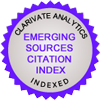Determination of heavy metal removal potential of the Samsun Coast mussel shells
Levent Gürel, Selahi GüneşEnvironmental Engineering Department, Engineering Faculty, Pamukkale University, Denizli, TurkeyThe removal capacity of mussel shells in removing heavy metals such as lead and nickel from wastewaters prepared synthetically was investigated by using the shells collected from Samsun Coasts within the scope of this work. In the studies, mussel shells were used in two different forms. In the first form, raw mussel shells were only grinded. On the other one, the mussel shells were pretreated by using sulfuric acid after grinding. The heavy metal removal potential of mussel shells were investigated using various variables such as pH, time and mussel shell dosage in experimental studies. Tests were conducted at 25°C constant temperature and a shaking speed of 150 rpm. The size of the mussel shell used in experimental studies was chosen as 45-125 µm. It was concluded from the results of the studies carried out by using raw mussel shells that the dominant mechanism was chemical precipitation according to the pH values after treatment process. It has been understood that the treatment mechanism was adsorption when the treatment performance of the pretreated mussel shells was in question. Lead and nickel ion concentrations were reduced from approximately 100 mg/L to 3.90 mg/L and 73.62 mg/L, respectively by using raw mussel shells. In the tests conducted with pretreated mussel shells, only lead removal was studied and lead concentration of approximately 100 mg/L was decreased to 9.22 mg/L at pH 2. Adsorbent uptake capacity was found to be 244.74 mg/g at 0.4 g/L mussel shell dosage for pretreated mussel shells.
Keywords: Black Sea mussel shell, Adsorption, Chemical precipitation, Heavy metal treatmentSamsun Sahili midye kabuklarının ağır metal giderim potansiyelinin belirlenmesi
Levent Gürel, Selahi GüneşPamukkale Üniversitesi, Mühendislik Fakültesi, Çevre Mühendisliği Bölümü, DenizliBu çalışma kapsamında Samsun Sahillerinden toplanan midye kabukları kullanılarak, bu kabukların sentetik olarak hazırlanmış atıksulardan kurşun ve nikel gibi ağır metalleri giderme kapasitesi araştırılmıştır. Yapılan çalışmalarda, midye kabukları iki ayrı şekilde kullanılmıştır. Bunlardan ilkinde, ham midye kabukları sadece öğütülmüştür. Diğerinde ise, kabuklar öğütüldükten sonra sülfürik asit kullanılarak ön arıtımdan geçirilmiştir. Deneysel çalışmalarda pH, zaman, midye kabuğu miktarı gibi çeşitli değişkenler kullanılarak midye kabuklarının ağır metal giderim potansiyeli incelenmiştir. Çalışmalar 25°C sabit sıcaklık ve 150 devir/dakika çalkalama hızında yürütülmüştür. Deneylerde kullanılan midye kabuğu boyutu 45-125 µm olarak seçilmiştir. Yapılan çalışmalar neticesinde elde edilen sonuçlara göre, ham olarak kullanılan midye kabuklarıyla yapılan deneylerde, arıtım sonrası pH değerleri dikkate alınarak, kimyasal çöktürme mekanizmasının hâkim mekanizma olduğu sonucuna varılmıştır. Ön arıtımlı (asitle muamele edilmiş) midye kabuklarının arıtım performansı incelendiğinde ise, meydana gelen arıtım mekanizmasının adsorpsiyonu temsil ettiği anlaşılmıştır. Ham midye kabukları kullanılarak, kurşun ve nikel iyonu konsantrasyonları yaklaşık olarak 100 mg/Lden sırasıyla en düşük 3.9 mg/L ve 73.62 mg/Lye indirilmiştir. Ön arıtımlı midye kabukları ile yapılan çalışmalarda ise sadece kurşun giderimi araştırılmış ve yaklaşık 100 mg/L olan başlangıç konsantrasyonu pH 2de 9.22 mg/Lye düşürülmüştür. Ön arıtımlı midye kabukları için adsorbent tutma kapasitesi (q) 0.4 g/L midye kabuğu dozajında 244.74 mg/g olarak bulunmuştur.
Anahtar Kelimeler: Karadeniz midye kabuğu, Adsorpsiyon, Kimyasal çöktürme, Ağır metal arıtımıCorresponding Author: Levent Gürel, Türkiye
Manuscript Language: Turkish






